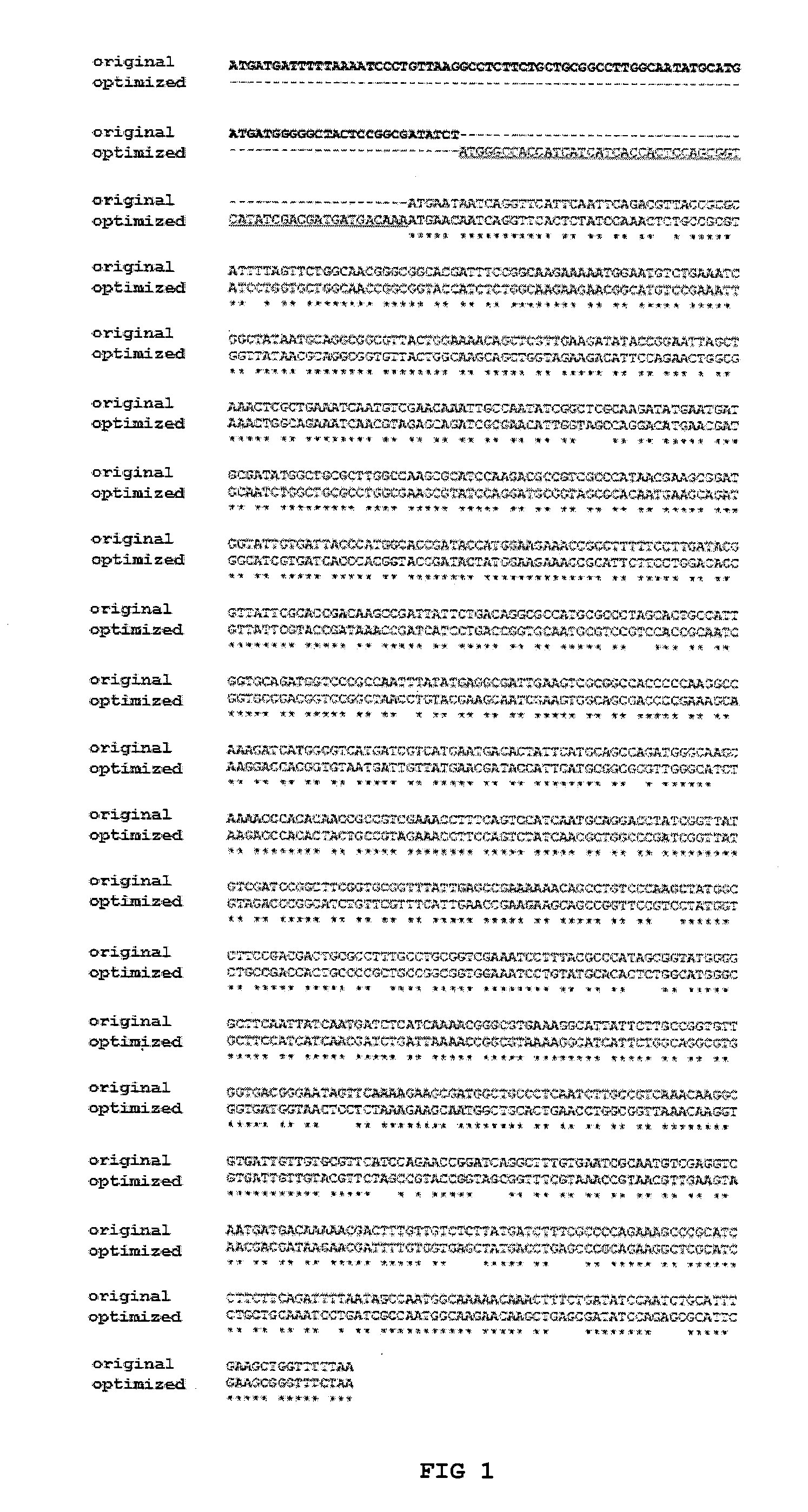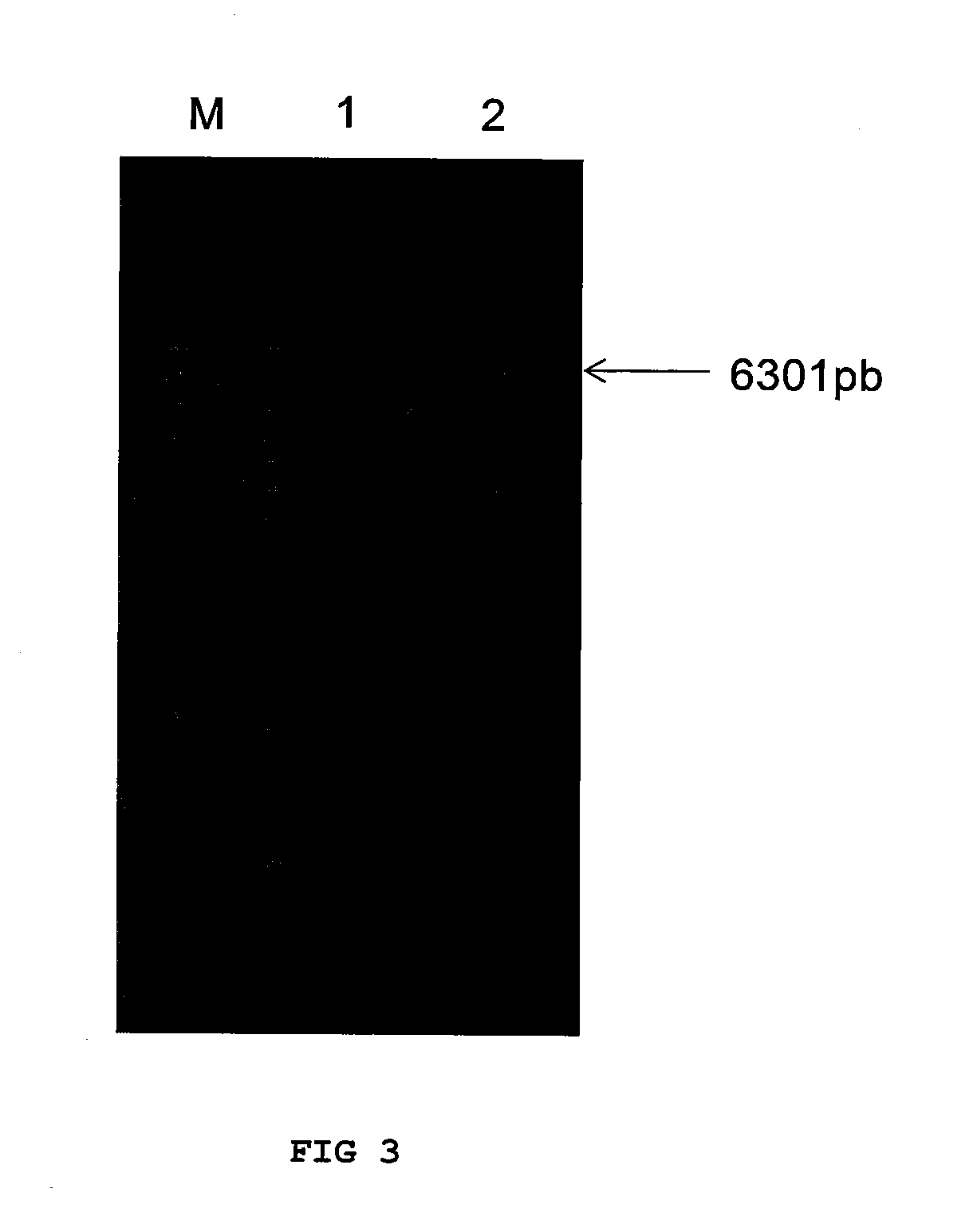Recombinant l-asparaginase from zymomonas
a technology of zymomonas and recombinant l-asparaginase, which is applied in the field of construction and optimization of synthetic lasparaginase gene zymomonas, can solve the problems of no documentation reporting the cloning and expression of recombinant l-asparaginase, and achieve the effect of reducing the cost of the final product and high production output and productivity
- Summary
- Abstract
- Description
- Claims
- Application Information
AI Technical Summary
Benefits of technology
Problems solved by technology
Method used
Image
Examples
example 1
Synthesis of the L-Asparaginase Gene
[0024]The gene type II of Zymomonas mobilis of the L-asparaginase gene was chemically synthesized by the company Epoch Life Science Inc. The design of the gene was performed using the sequence of the 1 01 nucleotides of the strain Zymomonas mobilis subsp. mobilis ZM4 gene deposited in the GenBank database by the 3189240 ID reference and illustrated herein as SEQ ID NO: 2, it sequence encodes a protein of 366 amino acids. The gene was synthesized based on the sequence of the L-asparaginase gene of Zymomonas mobilis subsp. mobilis ZM4 noted above, removing the nucleotides encoding the first 29 amino acids of the sequence, as those are part of a signal sequence (signal peptide). To that sequence was added a nucleotide sequence encoding six histidine, allowing the expression of the fused protein with a histidine tag at its N-terminus far end. Were also added nucleotides encoding the amino acid sequence: Asp-Asp-Asp-Asp-Lys, a cleavage site of the ente...
example 2
Transformation into Escherichia coli
[0026]Eletrocompetent E. coli DH5a and E. coli BL21 (DE3) cells were used as hosts for the plasmids pET26b / asparaginase and pET28a / asparaginase. The insertion of those plasmids in the cells was performed by electroporation. For the electroporation, the plasmids and 100 ul of eletrocompetent E. coli were gently mixed to avoid the formation of bubbles. Each mixture was transferred to a cuvette of 0.2 cm thick between the electrodes, and then subjected to an electric discharge for about 5 ms, with a voltage of 2.5 kV, capacitance of 25 pF and resistance of 200Ω at a eletroporator Gene Pulser® II (Bio-Rad). After the electric shock, were quickly added 1 mL of sterile LB medium and the mixture was incubated at 37° C. under agitation at 200 rpm for 1 hour. After this period, 200 pL of the mixture were spread on LB agar plate containing 50 pg / ml of canamictna. The plates were incubated at 37° C. for 16 hours. This procedure was first carried out with DH...
example 3
Analysis of L-Asparaginase Expression in Shake Flasks
[0028]To analyze the expression of the L-asparaginase enzyme cultures were performed in triplicate for each recombinant bacteria (E. coli BL21 (DE3) / p T28a / asparaginase and E. coli BL21 (DE3) / pET26b / asparaginase) in shake flasks. Therefore, each pre-inoculum was prepared by inoculating 10 uL of the Working Lot of the recombinant bacteria E. coli BL21 (DE3) / pET28a / asparaginase and E. coli BL21 (DE3) / pET26b / asparaginase in 10 ml of LB medium with 1% of glucose and 50 pg / ml of kanamycin. The pre-inoculum of each bacterium was incubated for 16 hours at 37° C. and 200 rpm in 50 ml shake flasks. After 16 hours, the inoculum of each bacterium was prepared in 50 ml of LB medium with 1% of glucose and 50 pg / ml of kanamycin were inoculated with 1 ml of the pre-inoculum in 250 mL flasks. The cultures were incubated at 37° C. and 200 rpm until they reached the exponential phase of growth (approximately 1.0 of 600 nm Absorbance). At this point...
PUM
| Property | Measurement | Unit |
|---|---|---|
| molecular weight | aaaaa | aaaaa |
| resistance | aaaaa | aaaaa |
| capacitance | aaaaa | aaaaa |
Abstract
Description
Claims
Application Information
 Login to View More
Login to View More - R&D
- Intellectual Property
- Life Sciences
- Materials
- Tech Scout
- Unparalleled Data Quality
- Higher Quality Content
- 60% Fewer Hallucinations
Browse by: Latest US Patents, China's latest patents, Technical Efficacy Thesaurus, Application Domain, Technology Topic, Popular Technical Reports.
© 2025 PatSnap. All rights reserved.Legal|Privacy policy|Modern Slavery Act Transparency Statement|Sitemap|About US| Contact US: help@patsnap.com



